Contents
Energy Conservation Business Plan
Green Power Consultancy is a start-up organization in Burlington, VT that offers designs and advice to architects and consumers regarding environmentally sensitive buildings and energy consumption. Green Power’s success relies on two key factors. Firstly, it only offers solutions based on market demand. Secondly, all offerings are economically justified, providing long-term economic value in addition to environmental benefits.
Green Power’s target customers are architects and individual consumers. By partnering with architects, Green Power enables them to offer environmental solutions to their customers. With a 7% growth rate in this group and 23 potential customers in the area, it has a promising market. The second customer group consists of environmentally conscious individuals looking for a service provider to incorporate their ethics into their new or existing structures.
Green Power is an environmental energy consultancy offering a wide range of services, including advice on passive heating, grey water usage, renewable energy, and employee transportation.
Leading Green Power is a seasoned management team comprising Dan and Sue Lang. Dan, with a degree in environmental studies and business, as well as a Masters in architecture, brings years of industry experience. Sue, with an MBA and work experience in the renewable energy department of the Bonneville Power Administration, complements the team. With their excellent education and work experience, they will successfully execute Green Power’s business plan.
Green Power forecasts conservative sales of $202,343 for year two, increasing to $238,402 for year three. Net profit is expected to be achieved in the second year. With a proven business model, a strong management team, and a comprehensive energy business plan, Green Power aims to be a long-lasting and profitable business.
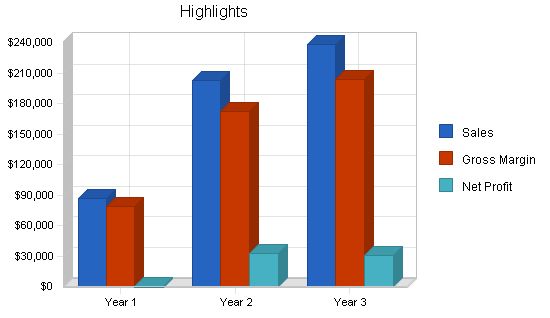
Mission
Green Power Consultancy aims to provide excellent green energy solutions for new constructions and existing building owners/lessors. Through analysis, customer support, and cost-effective solutions, Green Power will become a stable business serving the Burlington community.
Keys to Success
Green Power has identified several keys to success that will be instrumental in creating a sustainable business. Following these keys will significantly increase the likelihood of success.
- Offer customer-demanded solutions.
- Ensure economic considerations in all solutions.
- Provide 100% customer satisfaction by exceeding expectations.
Objectives
Green Power has identified three long-term objectives for the success of the business:
- Implement proven cost-benefit analysis environmental approaches to structure building, maintenance, and energy consumption.
- Become the premier environmental energy consultancy in the state within five years.
- Achieve profitability within three years.
Company Summary
Green Power is a Vermont-based green energy consultancy. They offer services to architects constructing new businesses and existing building owners/users aiming to improve their structure’s environmental impact.
Start-up Summary
In order to begin operations, Green Power will require the following equipment:
- Computer system with three workstations, standard and wide mouth printers, Internet access, and various software including Microsoft Office, QuickBooks, and CadArchitect.
- Three work areas including two drawing tables and office supplies.
- Bookshelves, lights, and couches for clients.
- Bike storage unit/locker.
- Refrigerator, microwave, and utensils for the lunch room.
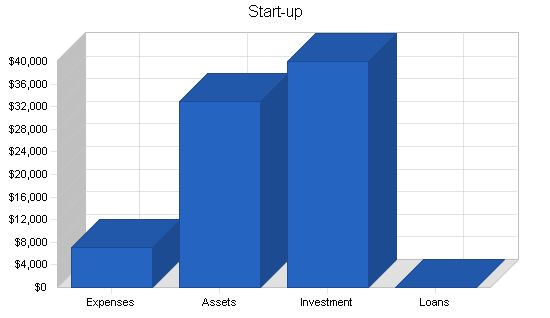
Start-up Funding:
Start-up Expenses to Fund: $7,150
Start-up Assets to Fund: $32,850
Total Funding Required: $40,000
Assets:
Non-cash Assets from Start-up: $9,000
Cash Requirements from Start-up: $23,850
Additional Cash Raised: $0
Cash Balance on Starting Date: $23,850
Total Assets: $32,850
Liabilities and Capital:
Liabilities:
Current Borrowing: $0
Long-term Liabilities: $0
Accounts Payable (Outstanding Bills): $0
Other Current Liabilities (interest-free): $0
Total Liabilities: $0
Capital:
Planned Investment:
Investor 1: $20,000
Investor 2: $20,000
Additional Investment Requirement: $0
Total Planned Investment: $40,000
Loss at Start-up (Start-up Expenses): ($7,150)
Total Capital: $32,850
Total Capital and Liabilities: $32,850
Total Funding: $40,000
Start-up Requirements:
Start-up Expenses:
Legal: $2,000
Stationery etc.: $200
Brochures: $200
Rent: $500
Research and Development: $3,500
Expensed Equipment: $750
Total Start-up Expenses: $7,150
Start-up Assets:
Cash Required: $23,850
Other Current Assets: $0
Long-term Assets: $9,000
Total Assets: $32,850
Total Requirements: $40,000
Company Ownership:
The two principal owners of Green Power are Dan and Sue Lang.
Services:
Green Power offers a range of environmentally-conscious energy solutions related to new and existing structures. The main areas of consulting that Green Power will offer are:
– Passive heating: This applies to the construction of new structures, designing the structure to capture and utilize heat generated naturally or as a by-product of the building. Examples include specific placement of heating vents, building and window design.
– Grey water: This is the capture and utilization of water that has been used for other purposes, such as faucets or rainwater that is no longer potable but can be used for toilet flushing or land irrigation.
– Renewable energy: This service offers customers information needed to make intelligent decisions regarding the use of renewable energy sources. Examples include wind power, photovoltaics, hydro power, biomass, and solar energy.
– Employee transportation: This service aims to reduce the energy consumed by employees traveling to work. Activities include outlining public transportation options, developing company-subsidized public/alternative transportation vouchers, and building bicycle lockers and shower facilities.
– Efficient building construction: This focuses on the use of local building materials and recycled materials to decrease energy demands.
Market Analysis Summary:
Green Power has segmented the market into two target groups: architects and individual customers. Green Power faces competition from eco-architects and local utilities that offer green energy consultation advice. End customers typically request green energy designs.
Market Segmentation:
Green Power has segmented its target market into two customer groups:
Architects:
– The architect firms typically have two to nine partners.
– They offer both residential and commercial design work, with 67% of their work being commercial.
– The firms typically have only a handful of service providers that they work with, developing long-term relationships.
– Yearly revenue ranges from $200,000 to $5 million.
Individual customers:
– This segment consists of consumers having residential homes or commercial structures designed.
– They have personal environmental concerns and recognize the cost-effectiveness of building with environmental considerations.
– They work directly with Green Power for their design needs and will likely take the design criteria to their builder.
– They are environmentalists who consider the impact of their actions on the environment.
– The age range of clients is 35-49.
– Average household income is $65,000. Cost-benefit analysis shows long-term cost effectiveness of adopting green energy.
– 89% of the group have at least an undergraduate degree, 26% have a graduate degree.
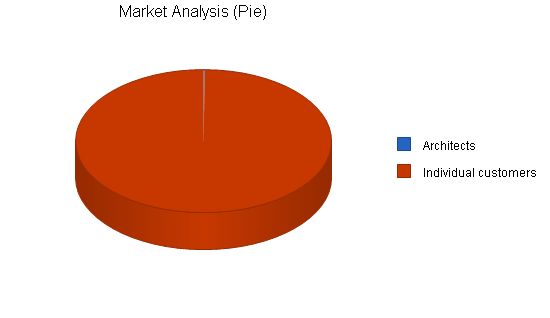
Market Analysis
| Market Analysis | |||||||
| Potential Customers | Growth | Year 1 | Year 2 | Year 3 | Year 4 | Year 5 | CAGR |
| Architects | 7% | 23 | 25 | 27 | 29 | 31 | 7.75% |
| Individual customers | 9% | 16,009 | 17,450 | 19,021 | 20,733 | 22,599 | 9.00% |
| Total | 9.00% | 16,032 | 17,475 | 19,048 | 20,762 | 22,630 | 9.00% |
Target Market Segment Strategy
Green Power has chosen these two market segments for compelling reasons. The architects are the service providers that do the bulk of the design work for residential and commercial structures. By aligning itself with architects, Green Power is able to offer its services to a larger group of people. Additionally, Green Power will serve individual customers. These are people who want environmental considerations made in the design of their structure. Burlington is a wonderful place to locate Green Power as there is a high population of environmentally-conscious people. By offering green energy services, Green Power allows this group of people to act on what they believe in.
Service Business Analysis
The environmental power consultancy industry is fairly new. Only recently has there been an emergence of firms that offer these services. This can be explained by several factors. First, people are becoming more environmentally aware these days. Another factor that has contributed to the growth of green power is that it has become increasingly cost effective to make business decisions while considering the environment. For years, environmental decisions were based on personal consciousness and ethics. Now money can be saved when environmental impacts are taken into account.
Competition and Buying Patterns
The competition generally takes two different forms:
Eco-architects: These architects specialize in environmental design considerations. Green Power could be within this industry niche, but they are able to serve a larger customer base, therefore earning more revenue and making a bigger impact.
Local utility: The local utilities often have a department that offers free consultation for environmental design considerations. However, their tips are not as comprehensive as those offered by a specialized firm like Green Power.
The buying pattern for consumers is currently being defined. Currently, purchasing decisions are typically made through architects or by doing research. As the industry becomes more mature, reputation and visibility/awareness will shape buying decisions. Price is less of a consideration since most service providers can offer a wide range of options.
Strategy and Implementation Summary
Green Power’s business strategy recognizes that a lot of business will be transacted through networking and word-of-mouth referrals. With this in mind, Green Power will build alliances with architects to increase its potential customer base. Green Power will rely on its competitive edge of adopting a cost-effective environmental solution and will highlight both environmental and economic attributes in its marketing strategy. The sales strategy will offer a compelling economic analysis of how customers can save money by adopting Green Power’s designs.
Competitive Edge
Green Power will use its competitive edge of economic justification to turn potential customers into qualified sales customers. Green Power will offer evidence that adopting their designs can save money in the long term and make a positive impact on the environment. Providing a cost benefit analysis for the green design is important because it makes the potential market larger.
Marketing Strategy
The marketing strategy is based on developing awareness of Green Power’s services to both architects and end-use consumers. Green Power will use networking to build relationships with architects and place advertisements in the local architect newsletter. To reach end-user customers, Green Power will use advertisements in the local paper and yellow pages, as well as participate in community-based seminars.
Sales Strategy
The sales strategy takes into account the philosophy that many people are attracted to Green Power because of its personal environmental ethics. The sales strategy will leverage this desire and the fact that environmental decisions can have positive economic impacts. Green Power will present customers with case studies and quantifiable data proving economic justification.
Sales Forecast
Green Power has adopted a conservative sales forecast for the business plan. Sales will be slow in the beginning but will grow as the customer pool increases and architects become familiar with Green Power’s services. Growth will be forecasted and preferenced as steady. Cost of sales for a consulting company are negligible, but the cost of architect sales will be 20% due to commissions paid for referrals.
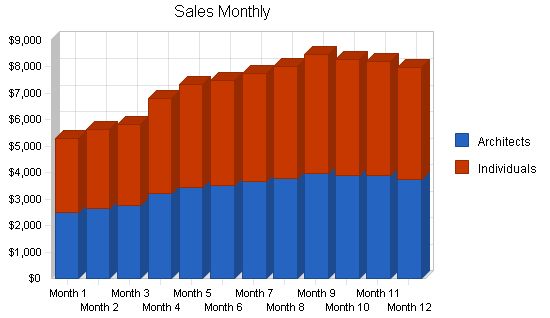
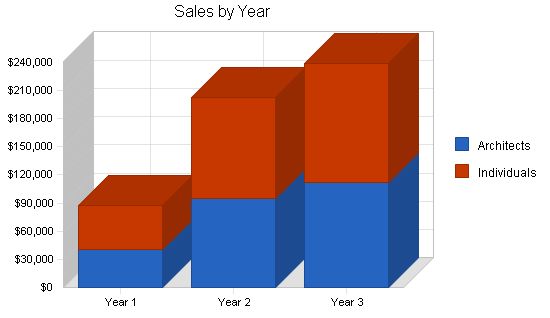
Sales Forecast
Architects:
Year 1: $41,060
Year 2: $95,445
Year 3: $112,454
Individuals:
Year 1: $45,987
Year 2: $106,898
Year 3: $125,948
Total Sales:
Year 1: $87,047
Year 2: $202,343
Year 3: $238,402
Direct Cost of Sales:
Architects:
Year 1: $8,212
Year 2: $19,089
Year 3: $22,491
Individuals:
Year 1: $0
Year 2: $10,690
Year 3: $12,595
Subtotal Direct Cost of Sales:
Year 1: $8,212
Year 2: $29,779
Year 3: $35,086
Milestones
Green Power has identified several milestones to set achievable goals. Achieving these goals can improve performance, as demonstrated by large corporations like GE’s Seven Sigma Program and state benchmark-based assessment testing systems. The milestones identified by Green Power are:
– Business plan completion
– 10th customer
– Revenues exceeding $50,000
– Profitability
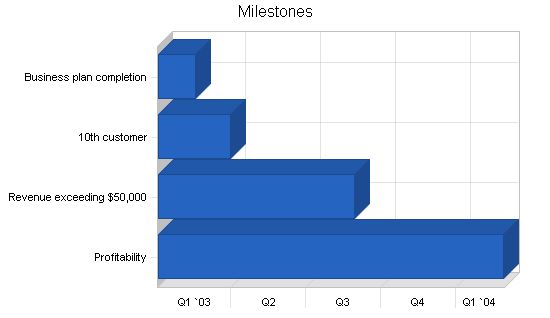
Milestones:
| Business plan completion | 1/1/2003 | 2/15/2003 | $0 | Dan & Sue | Business planning |
| 10th customer | 1/1/2003 | 3/30/2003 | $0 | Sue | Sales |
| Revenue exceeding $50,000 | 1/1/2003 | 8/30/2003 | $0 | Sue | Sales |
| Profitability | 1/1/2003 | 2/28/2004 | $0 | Dan | Accounting |
| Totals | – | – | $0 | – | – |
Web Plan Summary:
The website will be a marketing tool. It will offer a description of the services and a listing of clients served.
Website Marketing Strategy:
The plan for marketing the site is simple: submission to search engines like Google and listing the website on company correspondence and printed marketing/sales media.
Development Requirements:
Green Power will use a local programmer to build the site.
Management Summary:
The company will be led by Dan and Sue Lang. Dan grew up in Oregon and attended the University of Oregon for his undergraduate education. Dan’s major was environmental studies and business. After graduation, Dan worked for a year at an environmental testing company. Through networking, Dan was introduced to one of the principals of The Seal Company, a company making assessments for private and public companies regarding their environmental impact. His position with The Seal Company provided him with insight into the industry of environmental assessment and green energy. After a year, Dan enrolled in the University of Oregon’s Master’s Architect program, focusing on environmental design. This degree would provide Dan with skills to make a larger impact in his community.
Sue attended the University of Burlington for undergrad and then moved to Oregon to attend Willamette University’s MBA program. After her degree, Sue worked for the Bonneville Power Administration where she worked in their renewable resource division. Many of her projects focused on marketing and gaining public acceptance of renewable energy sources.
Personnel Plan:
For the first three months, the organization will consist of just Dan and Sue. Dan will be responsible for business-related issues, research, and work projects. Sue’s responsibilities will be marketing and sales. She will work on developing visibility for the company and working with prospective customers. Green Power has forecasted that on the fourth month, it will need administrative assistance. The duties will include answering the phone, input accounting, and other clerical functions. Initially, this person will be part-time but will move to full-time at the beginning of year two.
| Personnel Plan | |||
| Year 1 | Year 2 | Year 3 | |
| Dan | $24,000 | $30,000 | $36,000 |
| Sue | $24,000 | $30,000 | $36,000 |
| Associate consultant | $0 | $15,000 | $30,000 |
| Administrative assistant | $4,600 | $18,000 | $20,000 |
| Total People | 3 | 3 | 4 |
| Total Payroll | $52,600 | $93,000 | $122,000 |
Hello!
I’m Andrew Brooks, a seasoned finance consultant from the USA and the mind behind phonenumber247.com.
My career is built on a foundation of helping individuals and businesses thrive financially in an ever-changing economic landscape. At phonenumber247.com, my aim is to demystify the complex world of finance, providing clear, actionable advice that can help you navigate your financial journey with confidence. Whether it’s personal finance management, investment strategies, or understanding the nuances of market dynamics, I’m here to share insights and tools that can propel you towards your financial goals.
Welcome to my digital space, where every piece of advice is a step closer to financial clarity and success!
